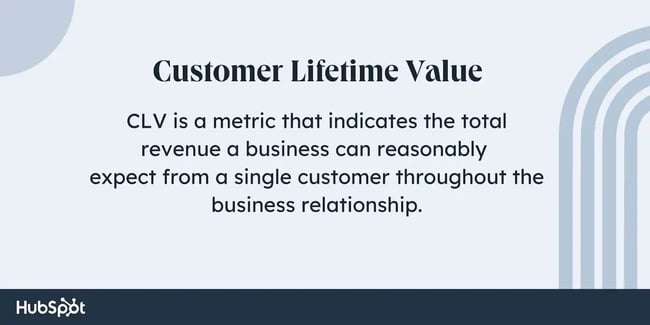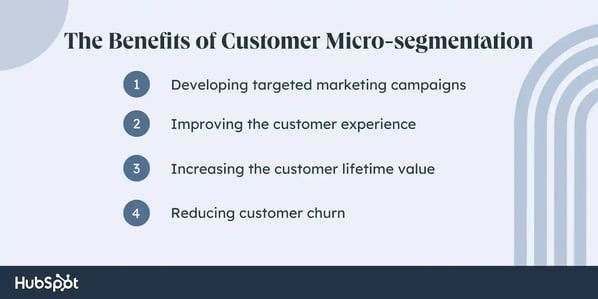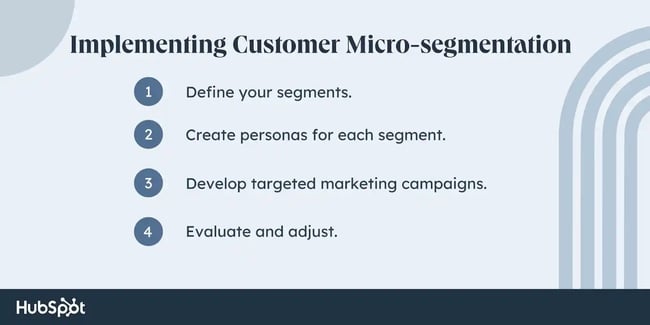Table of Contents
- What is micro-segmentation?
- What are the benefits of micro-segmentation?
- How to Implement Micro-Segmentation
- Tips for Implementing Micro-Segmentation
- Making the Most of Micro-Segmentation
What is micro-segmentation?
Micro-segmentation is the process of dividing a customer base into small, distinct groups. These groups, also called segments, are based on shared characteristics.
Segments can be based on any number of characteristics, but some common ones include:
- Behavioral data: How customers interact with your product or service — including frequency of use, customer journey, and customer lifetime value (LTV).
- Demographic data: Basic information about your customer base, such as race, location, and income.
- Psychographic data: Information about your customer's lifestyle, values, and personality.
Micro-segmentation is distinct from customer segmentation. While micro-segmentation creates small groups, customer segmentation relies on larger, more general categories — such as age, or gender.

What are the benefits of micro-segmentation?
Micro-segments can help your team connect to different types of customers. Other common benefits of micro-segmentation follow.
1. Developing Targeted Marketing Campaigns
By understanding each customer segment's specific needs and wants, you can create targeted marketing campaigns. This leads to higher conversion rates and ROI.
Targeted marketing campaigns are also more likely to result in customer loyalty and advocacy. In fact, 70% of consumers say they prefer customized advertising content and ads, according to a survey from Adlucent.
Through personalization, customers feel seen and heard. You can show your dedication to catering to their specific needs. As a result, they're more likely to stay with your brand for the long haul.
2. Improving the Customer Experience
With micro-segmentation, you can design custom experiences for each customer segment based on their specific needs. Customizing your interactions with customers creates a more compelling experience.
For example, let's say you have a particularly price-sensitive customer segment. You can design an experience that is focused on deals and discounts. If you have a customer segment that values convenience above all else, you can remove barriers so they can check out quickly.
3. Increasing the Customer Lifetime Value
When you better understand your customer segments, you can create targeted upsell and cross-sell campaigns. This can also help you increase your customer lifetime value (LTV).
Targeted campaigns are designed to sell complementary products and services to customers. If you know what each segment is interested in, you can create offers that increase LTV.

4. Reducing Customer Churn
Customer churn is when a customer stops doing business with you. By understanding which segments are at risk of churning, you can take steps to prevent it.
Using micro-segmentation, you can identify the customer segments that are at the highest risk of churning. You can then create targeted campaigns and offers to keep them engaged with your brand.
For example, you might offer a discount to customers in a segment that is at risk of churning. Or you might design a targeted marketing campaign that addresses the specific needs of that customer segment.

How to Implement Micro-Segmentation
So you've decided that you want to incorporate micro-segmentation in your strategy. Here's a step-by-step guide to implementing customer micro-segmentation in your business.

1. Define your segments.
The first step is to define your customer segments. To do this, you'll need to gather data on your customer base. This data can come from a variety of sources, including customer surveys, customer service records, and transaction data.
Then, you'll need to analyze the data to look for patterns and trends. This will help you identify the most common characteristics among each customer segment.
2. Create personas for each segment.
Once your segments are defined, it's time to create customer personas for each. A customer persona is a hypothetical person that represents a segment of your customer base. This helps bring your segment to life.
When creating customer personas, include information on their demographics, behaviors, needs, and motivations. This will help you create targeted marketing campaigns that are much more likely to resonate with each segment.
3. Develop targeted marketing campaigns.
Once your customer personas are created, it's time to develop targeted marketing campaigns for each segment. Ninety-one percent of customers are more likely to buy from a company that offers a personalized brand experience, so creating a targeted campaign is key.
To do this, start by brainstorming a list of marketing objectives that are relevant to each customer persona. Then, create a separate marketing plan for each customer persona. This plan should detail the specific tactics you'll use to reach your target customer and achieve your marketing objectives.
4. Evaluate and adjust.
After putting a customer micro-segmentation strategy in place, track your results and make adjustments as needed. This will help you ensure that your strategy positively impacts your business.
Some key metrics to track include customer acquisition rates, customer retention rates, customer lifetime value, and customer satisfaction levels. If you see a decline in any of these metrics, it may be time to adjust your strategy.
Tips for Implementing Customer Micro-Segmentation
When implementing micro-segmentation, start with the customer data that you already have. Then, analyze this data to look for patterns and trends.
Here are some other tips to help you get started.
- Focus on your most valuable customers. It's essential to focus on the segments of your customer base that are most valuable to your business. These are the customers that are most likely to make a purchase, so it's important to create targeted marketing campaigns that resonate with their needs and wants.
- Test and experiment. As you implement micro-segmentation, try different strategies and tactics. This will help you determine what works best for your business and your customer base.
- Track your results. Finally, it's important to track your results and make adjustments as needed. This will help you ensure that your micro-segmentation strategy is effective and positively impacts your business.
Making the Most of Micro-Segmentation
Micro-segmentation is a powerful marketing tool that can help you boost your conversion rates and improve your bottom line. By taking the time to understand your customer base, you can create experiences that are tailored to each customer's specific needs. This will lead to higher satisfaction levels and, ultimately, more revenue for your business.


